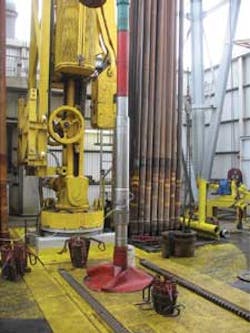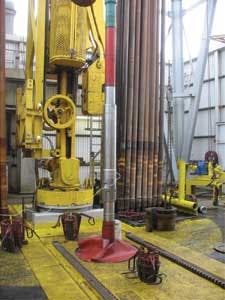P.2 ~ Closed loop underreaming improves deepwater drilling
View Article as Single page
The "underreaming risk and uncertainty" chart illustrates the relationship between risk/uncertainty in deepwater underreaming and a timeline from the year 2000. Significant sensing innovation occurred circa 2010 when new underreamer measurements were progressively introduced. Risk and uncertainty are highest when no measurements are taken and underreaming is inferred. Often, activation is inferred based on fluid pathways opening in the underreamer and a pressure differential seen at the rig floor. However, inferred underreaming provides mechanical or hydraulic information on the reamer which may or may not correspond with cutter position or the desired well diameter. Other inferred indicators of cutter block position include increased drilling torque when cutters interact with the formation, or pulling up the drillstring and underreamer to the previous hole size in order to see whether the top-drive stalls.
Wellbore measurements, if taken, are a separate activity performed after underreaming. The time-lag between enlargement and measurement leads to risk, uncertainty and unnecessary cost with corrective runs to attain the desired wellbore diameter.
The system provides novel wellbore diameter measurements by means of modular subs around 9 ft (3 m) long which are run typically with a drill collar or pony above the underreamer. The underreamer can also be configured as a string underreamer or a near-bit underreamer, or both, and provided with a stabilizer that can be expandable or fixed. Flexible BHA placement allows the modular subs to be placed either directly above the drill bit or a bull nose, or above a directional control system such as a rotary steerable system. The complete BHA can be modeled and optimized to meet ROP and drilling dynamics requirements.
The modular sub body allows for a through passage and full flow of drilling fluid from the drillstring and drop ball capability. This enables measurement of wellbore diameter accuracy above an underreamer and automatic detection of undergauge hole.
Caliper measurements of the actual diameter of the underreamed hole can partly reduce underreaming risk. They are a first step to achieving the pre-determined diameters required for close tolerance casing, and they also partly enable closed loop control of underreamers to deliver pre-determined wellbore diameters. However further action is necessary to reduce risk and uncertainty, namely tracking the reamer and providing actual underreamer status measurements.
Reamer measurements involve position sensing of moveable components within the tool and can be done indirectly or directly. Indirect sensing occurs when the position of a secondary component such as a sleeve or mandrel is sensed but the position of the cutter block itself is not. Direct sensing occurs when the position of the cutter block is measured as an outward extension corresponding to a pre-determined underreamer size. Direct sensing is advantageous as it positively determines the position of cutters, leading to increased efficiency. The system uses a magnetic direct sensing module which determines the displacement of the reamer cutter blocks. This can be fitted to any expandable reamer to track reamer positions.
Indirect position sensing, in contrast, provides no significant advantage over inferred underreaming and leads to low efficiency gains. Even with direct position sensing only a medium-sized gain in efficiency results. This is because wellbore diameter is not solely a function of the status of underreamer cutter position. Cutters could be worn or lost, or the formation could creep into the hole. Cutter position measurements alone cannot distinguish among these three conditions.
Efficiency gains
For deepwater and subsalt wells the highest efficiency gains arise with direct position sensing and calliper measurements. The chart highlights the increased efficiency that results from comparing and correlating calliper measurements of wellbore diameter with measurements of cutter block positions. Comparative measurements offer solutions to a broad set of operational problems that cannot be solved otherwise. Firstly, wellbore diameter measurements provide a map of radial creep, swelling, rubble zones, or wash outs. Second, position sensors measure the actual underreamer cutter extension. The comparison process offers deepwater drilling engineers a reliable method of achieving good hole quality and eliminating uncertainty.
Correlated measurements also ensure gauge hole is delivered. The drilling engineer can achieve the drilling program objectives more easily by being able to compare the calliper data with direct position sensing in order to confirm whether the cutter blocks are fully extended, partially retracted, or missing completely.
Comparative measurements provide new insight into downhole conditions and can be configured to meet the user's well objectives. Software can be programmed to cross-check the cutter block positional data from magnetic sensors placed on the cutter housing, which can be retrofitted to existing reamers. This shows whether the block has actually been extended. If the block has extended yet the calliper data shows that the actual wellbore is below the planned wellbore size, the user can be alerted by means of mud pulse telemetry or wired pipe to take diagnostic action. Operational parameters can be modified or secondary reamers can be activated to save a trip.

